Quantum non Eraser 量子非消去実験
Introduction
The delayed choice quantum eraser experiment gives interesting results. If you want to know how to do it, please go to YouTube.
遅延選択量子消しゴム実験では興味深い結果が得られる。 動画で手っ取り早く見たい方はYouTubeへどうぞ。
In this experiment, the spatial distribution corresponding to the X₀ value of R₀n, which is the correlation result between the detectors D₀ and Dn (n is 1 to 4), is measured using the experimental apparatus as shown in the following figure.
本実験では、以下の図のような実験装置を用いて、検出器D₀とDn(n=1〜4)の相関結果であるR₀nのX₀値に応じた空間分布を計測する。
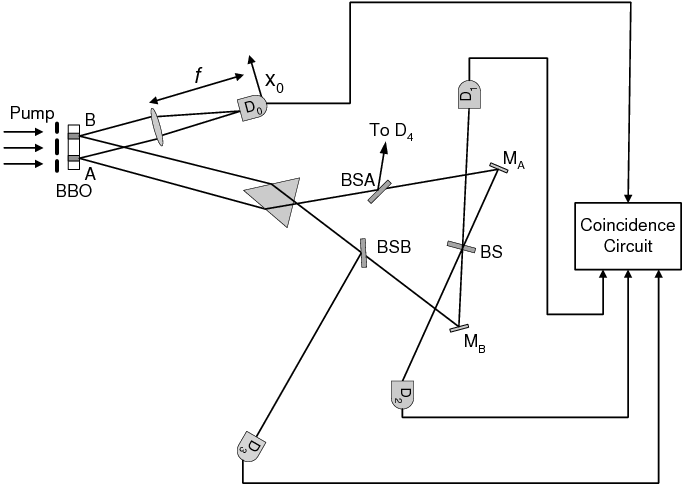
Delayed "Choice" quantum eraser - SemanticScholar
No interference fringes can be seen in either R₀₃ + R₀₄, which is the data when the path is measured, or R₀₁ + R₀₂, which is the data when the path is not measured. This is because the phase is randomly perturbed during the conversion of a photon into a pair of entangled photons in the BBO.
経路測定した場合のデータであるR₀₃+R₀₄も経路測定しなかった場合のデータであるR₀₁+R₀₂も、どちらも干渉縞が見られない。 その原因は、1個の光子がBBOで量子もつれ状態の1対の光子に変換される過程で位相がランダムに乱されるからである。
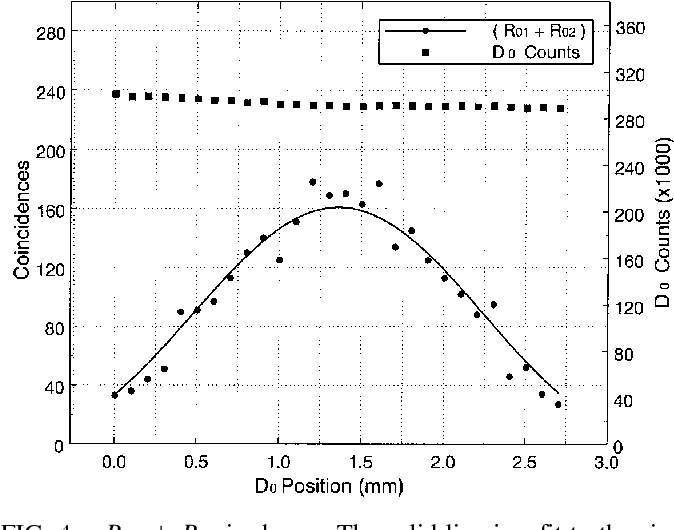
Delayed "Choice" quantum eraser - SemanticScholar
Here, further, data is extracted based on the result of measuring the initial phase difference between the path A side and the path B side. The path to D₁ and D₂ is a so-called Mach-Zehnder interferometer itself, and when a result whose initial phase difference is close to φ is extracted at R₀₁, a result whose initial phase difference is close to φ + 180 ° is extracted at R₀₂. As a result, interference fringes of opposite patterns are extracted in R₀₁ and R₀₂, respectively.
ここで、さらに、A側とB側の初期位相差を測定した結果に基づいてデータを抽出する。 D₁とD₂に向かう経路はいわゆるマッハ・ツェンダー干渉計そのものであり、R₀₁にて初期位相差がφに近い結果が抽出される場合は、R₀₂では初期位相差がφ+180°に近い結果が抽出される。 その結果、R₀₁とR₀₂ではそれぞれ逆パターンの干渉縞が抽出される。
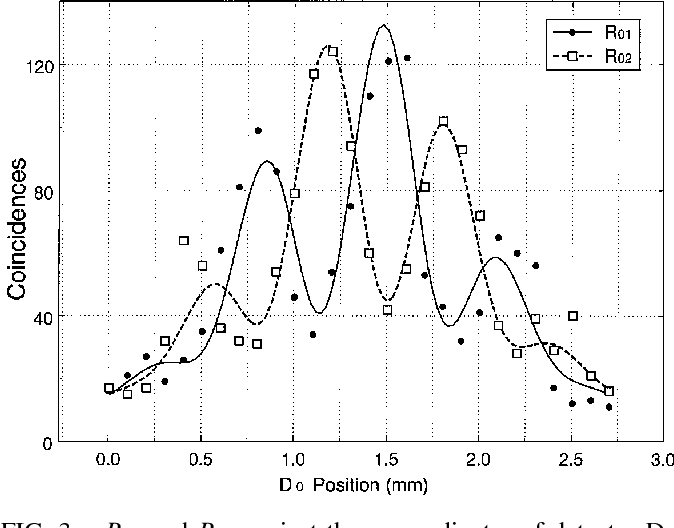
Delayed "Choice" quantum eraser - SemanticScholar
The following table summarizes the above.
| No path measurement | With path measurement | |
|---|---|---|
| No correlation with phase measurement results | R₀₁+R₀₂:hide interference frings | R₀₃+R₀₄:hide interference frings |
| With correlation with phase measurement results | R₀₁ or R₀₂:appear interference fringes | (no experiment) |
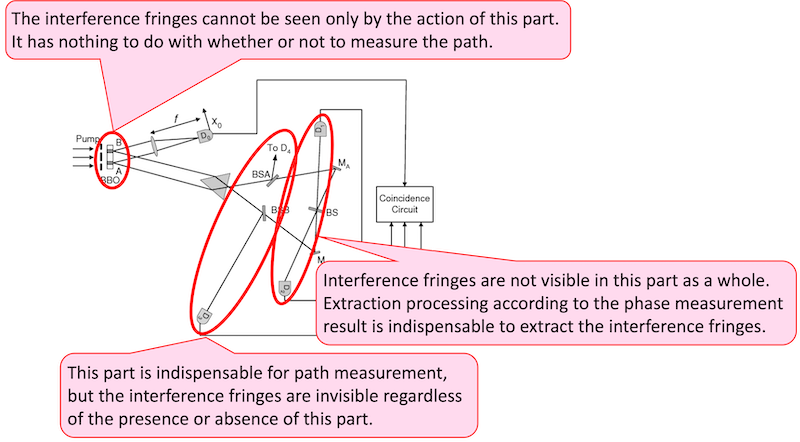
以上をまとめると次の表のようになる。
| 経路測定なし | 経路測定あり | |
|---|---|---|
| 位相測定結果との相関なし | R₀₁+R₀₂:干渉縞消失 | R₀₃+R₀₄:干渉縞消失 |
| 位相測定結果との相関あり | R₀₁またはR₀₂:干渉縞復活 | (未実験) |
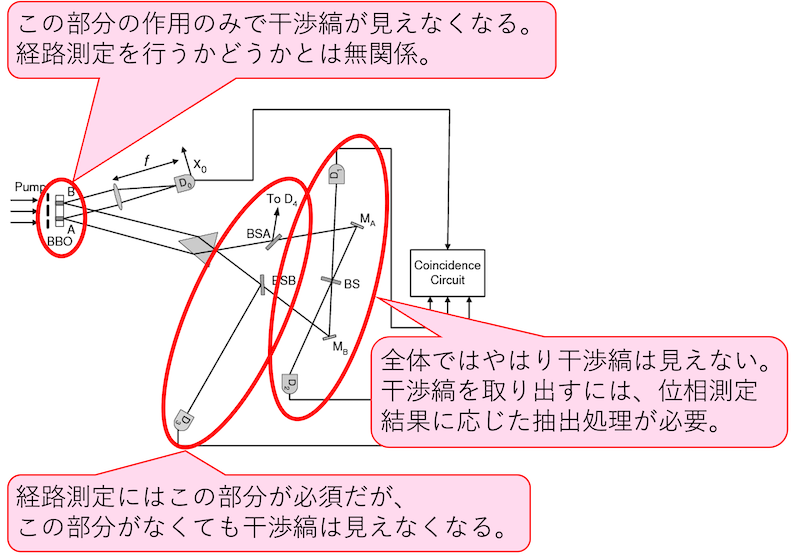
In this experiment, the path measurement and the interference fringes were not compatible, because the path measurement and the phase measurement cannot be performed simultaneously. Therefore, when the path is measured, it is not possible to extract the data according to the phase measurement result. Therefore, when the path is measured, it cannot be verified whether or not there are hidden interference fringes that cancel each other out.
この実験では、経路測定と干渉縞は両立できなかったが、それは、経路測定と位相測定を同時に行うことはできないからである。 そのため、経路測定した場合には位相測定結果に応じたデータの抽出ができない。 よって、経路測定した場合には、お互いに相殺し合う隠れた干渉縞が存在するのかどうか検証できない。
Proposal of Quantum non-Eraser
Abstract
This proposal is an experimental validation of the untested portion of the table. Therefore, the following experiment is proposed as a method for simultaneously performing the path measurement and the phase measurement.
本提唱は、表の未実験部分を実験で検証するものである。 そのため、経路測定と位相測定を同時に行う方法として、以下の実験を提唱する。
Method
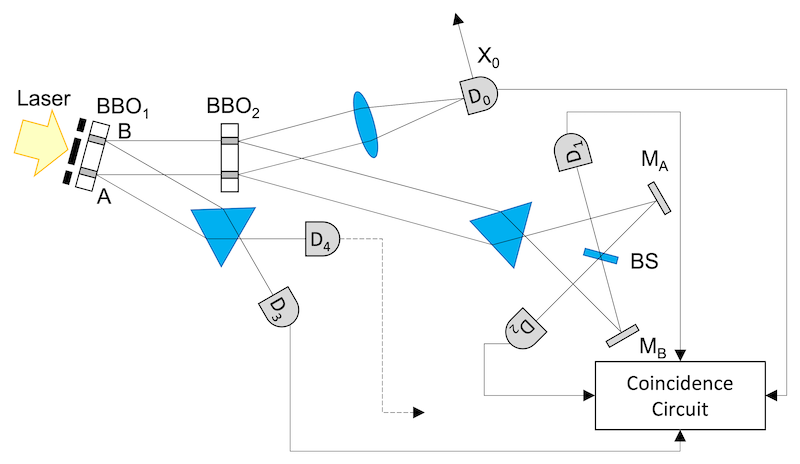
With this experimental setup, the spatial distribution according to the X₀ value of R₀nm, which is the correlation result of D₀ and Dn (n is 1 or 2) and Dm (m is 3 or 4), is measured.
この実験装置でD₀とDn(n=1,2)とDm(m=3,4)の相関結果であるR₀nmのX₀値に応じた空間分布を計測する。
Forecast
Inferring from the results of the delayed selective quantum eraser experiment, it is considered that interference fringes do not occur in R₀₁₃ + R₀₂₃ and R₀₁₄ + R₀₂₄ because the data is not extracted according to the phase measurement result. On the other hand, since R₀₁₃ + R₀₁₄ and R₀₂₃ + R₀₂₄ are extracting data according to the phase measurement results, it is considered that two interference fringes with opposite patterns occur to each other. Even if this is separated into R₀₁₃, R₀₁₄, R₀₂₃, and R₀₂₄, there is no reason why the interference fringes disappear, so it is considered that the interference fringes remain. Therefore, interference fringes can be obtained even when the path is measured.
遅延選択量子消しゴム実験の結果から推測すると、R₀₁₃+R₀₂₃およびR₀₁₄+R₀₂₄は位相測定結果に応じたデータの抽出を行っていないので干渉縞が生じないと考えられる。 一方で、R₀₁₃+R₀₁₄およびR₀₂₃+R₀₂₄は位相測定結果に応じたデータの抽出を行っているので、逆パターンの2つの干渉縞が生じると考えられる。 これをR₀₁₃とR₀₁₄とR₀₂₃とR₀₂₄に分離した場合も、干渉縞が消える理由が考えられないので、干渉縞は残るものと考えられる。 よって、経路測定した場合も干渉縞が得られることになる。
The following is a summary of the above.
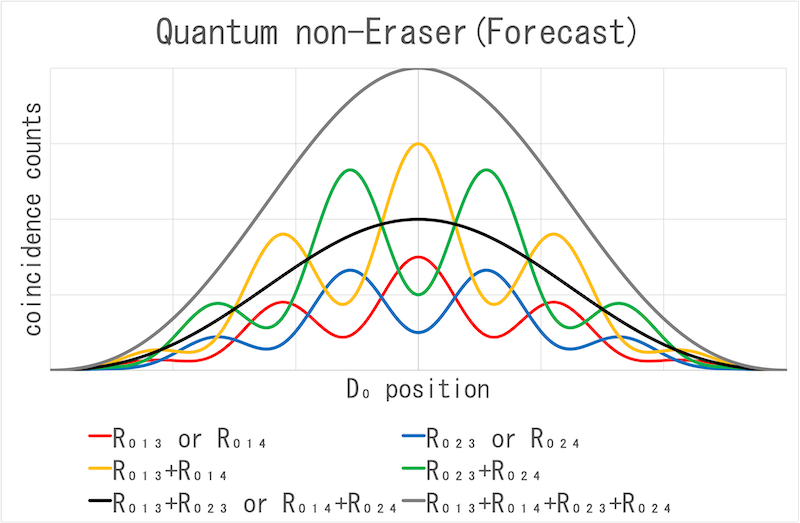
| No path measurement | With path measurement | |
|---|---|---|
| No correlation with phase measurement results | R₀₁₃+R₀₁₄+R₀₂₃+R₀₂₄:hide interference frings | R₀₁₃+R₀₂₃ or R₀₁₄+R₀₂₄:hide interference frings |
| With correlation with phase measurement results | R₀₁₃+R₀₁₄ or R₀₂₃+R₀₂₄:appear interference fringes | R₀₁₃ or R₀₁₄ or R₀₂₃ or R₀₂₄:appear interference fringes |
以上をまとめると次のようになる。

| 経路測定なし | 経路測定あり | |
|---|---|---|
| 位相測定結果との相関なし | R₀₁₃+R₀₁₄+R₀₂₃+R₀₂₄:干渉縞消失 | R₀₁₃+R₀₂₃またはR₀₁₄+R₀₂₄:干渉縞消失 |
| 位相測定結果との相関あり | R₀₁₃+R₀₁₄またはR₀₂₃+R₀₂₄:干渉縞復活 | R₀₁₃またはR₀₁₄またはR₀₂₃またはR₀₂₄:干渉縞復活 |
Issues and Solutions
The problem here is whether the path detected by D₃ or D₄ matches the path to reach D₀, that is, whether the result detected by D₃ or D₄ is the path information. The following experimental equipment is required to verify this.
ここで問題となることはD₃やD₄で検出した経路が、D₀に到達する経路と一致しているかどうか、すなわち、D₃やD₄で検出した結果が経路情報となっているかである。 それを検証するには以下のような実験装置が必要となる。
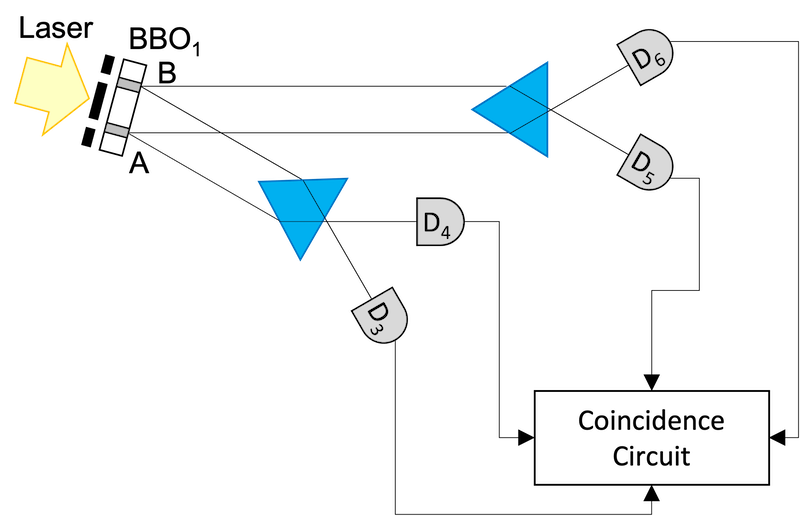
This experimental setup measures Cnm, which is the correlated number of Dn (n is 3 or 4) and Dm (m is 5 or 6). If the paths match, then C₃₅》 C₃₆ and C₄₆》 C₄₅ should be established. If C₃₅≈C₃₆ and C₄₆≈C₄₅, the detection results of D₃ and D₄ cannot be used for path measurement. If the detection results of D₃ and D₄ cannot be used for path measurement, the interference fringes disappear when information other than the path information is obtained in the delayed choice quantum eraser experiment.
この実験装置でDn(n=3,4)とDm(m=5,6)の相関した数であるCnmを計測する。 経路が一致するなら、C₃₅》C₃₆およびC₄₆》C₄₅が成立するはずである。 もしも、C₃₅≈C₃₆およびC₄₆≈C₄₅であれば、D₃やD₄の検出結果は経路測定には使えない。 D₃やD₄の検出結果が経路測定には使えないなら、遅延選択量子消しゴム実験では経路情報以外の情報を得た場合に干渉縞が消えていることになる。
In addition, the following experimental setup will be required for the verification of this proposal.
本提唱の検証には、さらに、次のような実験装置も必要となろう。
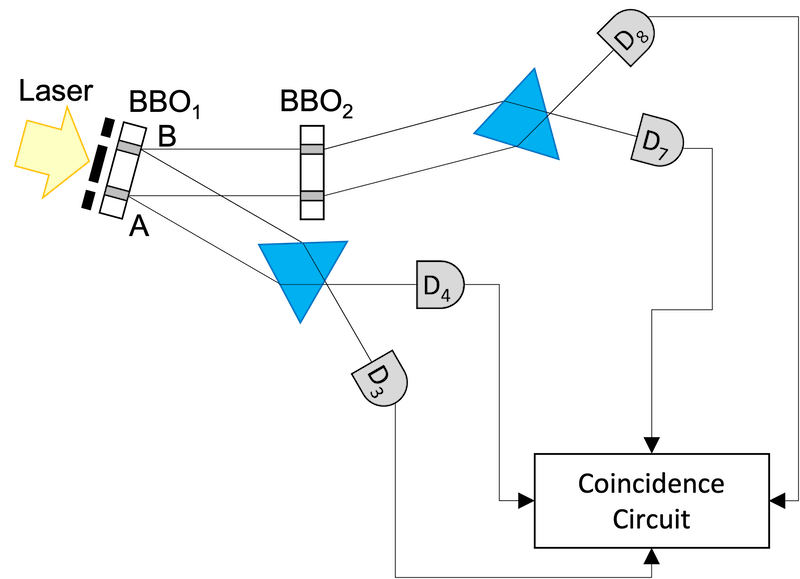
This experimental setup measures Cnm, which is the correlated number of Dn (n is 3 or 4) and Dm (m is 7 or 8). If the paths match, then C₃₇》 C₃₈ and C₄₈》 C₄₇ should be established. If C₃₇ ≈ C₃₈ and C₄₈ ≈ C₄₇, the detection results of D₃ and D₄ cannot be used for path measurement.
この実験装置でDn(n=3,4)とDm(m=7,8)の相関した数であるCnmを計測する。 経路が一致するなら、C₃₇》C₃₈およびC₄₈》C₄₇が成立するはずである。 もしも、C₃₇≈C₃₈およびC₄₈≈C₄₇であれば、D₃やD₄の検出結果は経路測定には使えない。
The interference fringes when the path can be measured in this proposed experiment are blurred. Therefore, the explanation that "the path correct rate has decreased by the mixture of the patterns in the case where the path cannot be measured" can be established. Therefore, depending on the value of the path correct rate, it cannot be said that the path measurement and the interference fringe are compatible. When the interference fringes are restored, a pattern in which the patterns with and without interference are mixed one-to-one is obtained. That is, this pattern is considered to be a state in which the pattern in which the interference fringes are obtained and the pattern in which the interference fringes are not obtained are mixed by half. Therefore, if the path cannot be measured when the interference fringes are obtained and the path can be measured when the interference fringes cannot be obtained, the probability that the path can be measured should be about 50%. Here, it is assumed that the path correct rate when the path can be measured is 100% and the path correct rate when the path cannot be measured is 50%. In this case, if he probability that the path can be measured should be about 50%, the path correct rate should be 75%. Therefore, if the path correct rate is about 75%, it cannot be said that the path measurement and the interference fringes are compatible. Conversely, if the path correct rate significantly exceeds 75%, it means that the path can be measured even when the interference fringes are obtained.
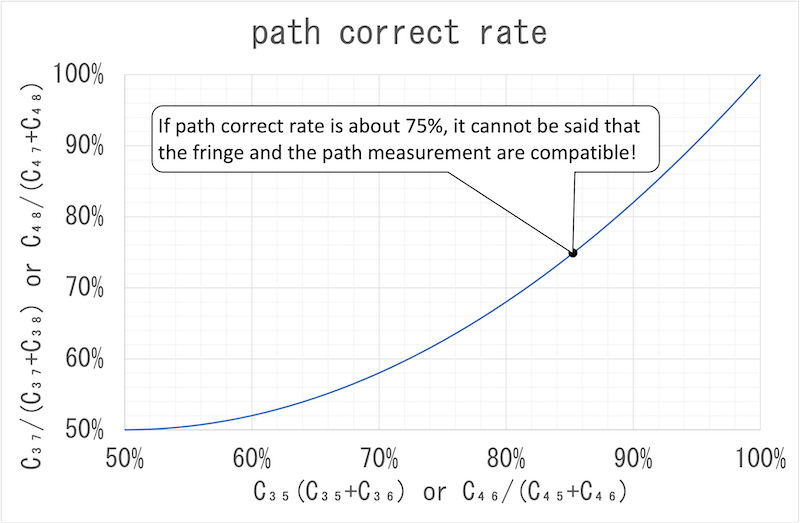
本提唱実験で経路測定できる場合の干渉縞はぼやけている。 よって、「経路測定できない場合のパターンが混じった分だけ経路的中率が下がった」という説明が成立し得る。 だから、経路的中率の値によっては経路測定と干渉縞が両立したとは言えなくなる。 干渉縞が復活する場合は、干渉ありと干渉なしのパターンをそれぞれ1対1で混合したようなパターンが得られる。 つまり、このパターンは干渉縞が得られるパターンと、得られないパターンが、それぞれ、半分ずつ混じり合っている状態と考えられる。 もしも、干渉縞が得られる場合に経路測定ができず、かつ、干渉縞が得られない場合に経路測定が可能であるならば、経路測定できる確率は約50%となっているはずである。 ここで、経路測定できる場合の経路的中率を100%、経路測定できない場合の経路的中率を50%と仮定する。 この場合、経路測定できる確率が約50%なら、経路的中率は75%となるはずである。 よって、経路的中率が75%前後であれば、経路測定と干渉縞が両立したとは言えない。 逆に、経路的中率が75%を有意に超えるならば、干渉縞が得られる場合にも経路測定できていることになる。
Discussion
If R₀₁₃, R₀₁₄, R₀₂₃, R₀₂₄ are the expected results and the path correct rate significantly exceeds 75%, it means that the pathway information and the interference fringes are compatible in this proposed experiment. It reveals that the cause of the disappearance of the fringes is the physical action associated with the measurement, and the path measurement is not the cause but the result of the physical action. This would overturn the traditional view of quantum mechanics complementarity.
R₀₁₃,R₀₁₄,R₀₂₃,R₀₂₄が予測通りの結果であり、かつ、経路的中率が75%を有意に超えれば、本提唱実験で経路情報と干渉縞が両立できたことになる。 それは、干渉縞消失の原因が測定に伴う物理的作用であって、経路測定は原因ではなく当該物理的作用がもたらした結果であることを明らかにする。 これは量子力学の相補性に関する従来の見解を覆すこととなろう。
Conclusion
If the proposed experiment is successful, it can be a new finding of quantum mechanics. However, if it fails, it cannot be said that the possibility of confounding factors has disappeared, and new experiments will be required to find out the truth.
本提唱実験が成功すれば量子力学の新たな知見となり得る。 しかし、失敗した場合は、交絡因子の可能性が潰えたとは言えず、真相究明には新たな実験が必要となろう。
総合案内
科学一般
疑似科学等
- 疑似科学
- 数学や科学への無理解
- 疑似科学を批判する疑似科学
- STAP細胞論文捏造事件
- CCS地震原因説
- 地球温暖化懐疑論
- 疑似科学者列伝